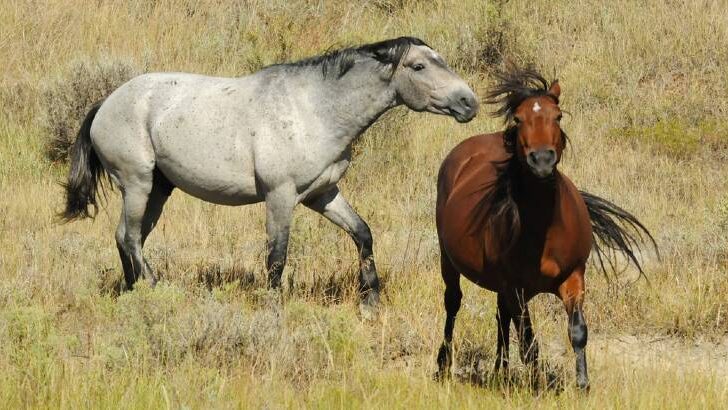Affiliate Disclaimer
As an Amazon Associate I earn from qualifying purchases. It helps me keep the website going. Thank you for your support.
Just like humans, horses can bully each other. In most cases, horses exhibit some form of dominant behavior to establish or maintain rank within a herd. But what happens when this behavior goes too far? Equine bullying can cause considerable harm to other horses, both physically and mentally. But how can you stop a horse from bullying other horses?
Stopping a horse from bullying other horses requires the cause of the behavior to be identified and addressed. Inadequate social skills, training, or resources like food, water, or shelter can all contribute to bullying. Additionally, some horses bully due to their own fear, frustration, or anxiety. Understanding the reasons behind horse bullying and how herd dynamics work is key to creating a harmonious herd.
Dealing with the equine bully requires an approach that considers the needs of all the horses involved. Read on to learn more about why horses bully other horses and what you can do to stop the equine bully.
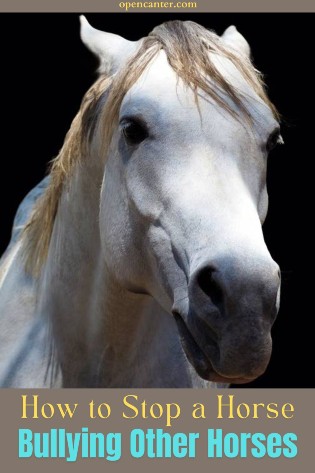
What is Horse Bullying?
Just like humans, horses can also bully one another. In the human world, bullying means intentionally and repeatedly harming or intimidating someone. For horses, bullying occurs when a dominant horse continuously displays aggressive behavior towards another horse.
Here are some examples of the most common bullying behaviors:
- Biting
- Kicking
- Striking
- Chasing – either around the pasture or away from food or water
- Herding – forcing the other horse to go where the bully wants to go
- Pinning the ears back at the other horse
- Baring teeth
- Preventing other horses from accessing food or water
- Fighting
In most cases, these behaviors are easily observed. Even if you don’t witness the bullying, it can be easy to tell when a horse is bullying other horses. Their field mates may have bite marks, injuries from kicks, or ripped rugs.
What can be more difficult to spot is the herding and possessive behaviors. In these instances, the victim generally won’t be sporting injuries. However, the negative effects might be more gradual.
For example, the horse who is unable to access a shared bale of hay in the paddock will slowly lose weight. You might also observe that the bully always has access to the field shelter, while everyone else has to stand outside.
However, there is a key difference to outline when it comes to bullying behavior in horses. Because of their social dynamics, horses naturally exhibit some of the behaviors listed above. However, this is usually a minor one-off or infrequent event.
It is when these behaviors become constant, or start to cause consistent or serious injuries, that it becomes a concern. This is where the line between normal dominant behavior and equine bullying starts to be crossed.
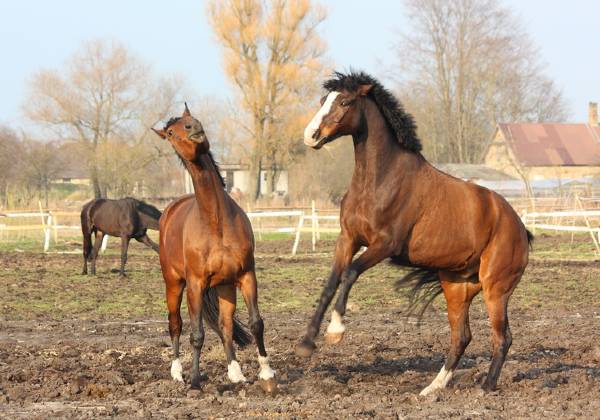
Understanding Herd Structure
To understand why some horses bully other horses, you need to understand herd structure. This refers to how horses form relationships and interact with each other. These behaviors stem from how horses organized themselves in the wild.
In a herd of horses, there is a hierarchical structure. One horse acts as the leader, with others having a rank below them. Horses are prey animals, and their survival depended on having a leader who could help protect them from harm.
In wild horse herds, the herd leader is usually an older mare. While she may not be the strongest or the fastest horse in the herd, she is the wisest. The herd leader is responsible for helping the herd identify threats, avoid predators, and to find food and water.
The stallion is the dominant protector of the herd. He needs to protect the herd from the advances of other stallions. As soon as he becomes too old, he is replaced by a younger stallion. (source)
In domestic environments, we can still see the same herd dynamics at play. For example, in a small group of horses, the leader will be the one who makes decisions. This could mean deciding when to drink, where to seek shelter, or which food pile to eat from.
The leader will exhibit some of the more minor bullying behaviors, on occasion. This could be chasing another horse away to another food pile, or jockeying for the best shelter position. Most of the time, this behavior extends no further than putting ears back or minor nips.
Why do Horses Bully Other Horses?
In order to stop a horse bullying other horses, you first need to understand why they are being a bully. Remember, bullying extends further than dominant behavior to develop or maintain a pecking order. It involves consistent aggressive behavior.
There are four key reasons why a horse would bully other horses:
In order to stop a horse bullying other horses, you first need to understand why they are being a bully. Remember, bullying extends further than dominant behavior to develop or maintain a pecking order. It involves consistent aggressive behavior.
There are four key reasons why a horse would bully other horses:
These horses simply do not understand how to interact with other horses. They did not have adequate social opportunities as a young horse. They try to establish dominance over other horses but do not understand boundaries or know when to stop. This can be common in foals who were hand-reared.
2) Fear and insecurity
In some cases, equine bullies are simply exhibiting their ‘fight’ response to a perceived threat; which happens to be another horse. They perhaps have tried the ‘flight’ or ‘run away’ response with no luck and have changed their tactics. These horses are simply trying to cope with their insecurities around other horses.
3) Stress or discomfort
Horses who are stressed or upset may direct their feelings toward other horses. This can be displayed as bullying behavior. It is just like if we come home after a bad day at work and take out our frustration on someone at home.
4) Resource Protection
Competition over things like food, water, or shelter can be a trigger for bullying behavior. All of these things are essential for survival and if they are scarce, horses will literally fight for survival.
The strategy to stop a horse from bullying other horses will depend on the underpinning reason for the bullying. By first making sure you understand the reasons behind horse bullying, you can develop a targeted strategy.
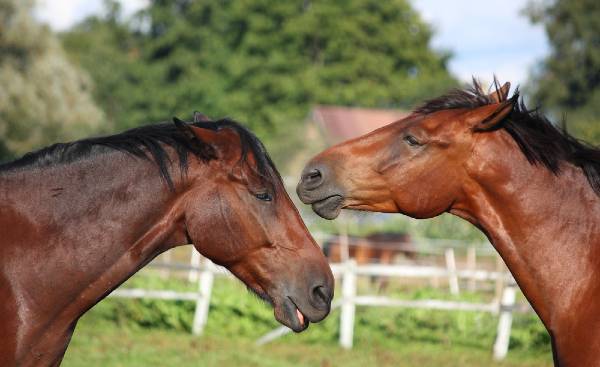
Do Horses Bully Humans?
Yes, horses can bully humans. They can direct the same types of behavior toward their handlers as they do other horses. Usually, a horse expresses bullying behavior towards a person because they are trying to establish dominance.
This is why it is important that we establish ourselves as our horse’s leader. We can do this by communicating clearly and consistently with our horses. Be confident when handling horses, so that they see you as an effective leader.
Horses are more likely to be dominant towards people who are tentative around horses. The horse knows that the person is not confident in their own skills, and is not fit as a leader. So, the horse then uses dominant behavior to establish itself as the leader in the relationship.
Horses can also exhibit bullying behavior if they are consistently given treats. The horse comes to expect that it will receive a treat at a certain time or after a certain task. They can start to nudge or nip people, to indicate that they want the treat. This can escalate into very dangerous situations like charging, pushing, or biting.
If your horse is bullying you, you may need to seek help from a professional trainer. They will be able to guide you through training exercises to help you establish yourself as the leader. They will also be able to help retrain your horse’s existing behavior to make them easier and safer to handle.
Some horses are so aggressive towards people that they are unable to be handled. In most cases, this is because the horse is scared of people. They are exhibiting the ‘fight’ part of their ‘fight or flight’ response. However, some horses simply have been able to get away with dangerously dominant behavior for too long.
How Do You Stop a Horse From Bullying Other Horses?
To start with, you must first work out why your horse is bullying other horses. This will help you know where to start to resolve the problem. Consider all aspects of your horse’s routine and history when you are trying to pinpoint the cause of the problem.
For example, the horse who is bullying others due to lack of socialization may have been an orphan foal. Or, they may have only ever been kept in a field or stable by themselves. If the field only has one shared feed source, the bullying might be due to resource protection.
Horses who bully due to a lack of socialization need time to learn the right social skills. Begin by keeping your horse next door to their herd mates. This will allow them to interact with a boundary in between.
Gradually introduce field mates one at a time. Monitor their behavior and give plenty of time for the bully to learn new social skills. It is recommended to use an older, more experienced horse to teach the bully.
For horses that are fearful or stressed, you need to evaluate their environment to make sure it is stress-free. Avoid overcrowding fields, and make sure there is plenty of access to water and feed. Make sure your horse has a consistent routine and set of herd mates.
To avoid bullying due to resource protection, place feed across multiple feeding stations. Each horse should have their own station, far enough apart that one horse cannot dominate two stations. Water should be situated away from feed and shelter areas, and in a place where horses can’t be cornered.
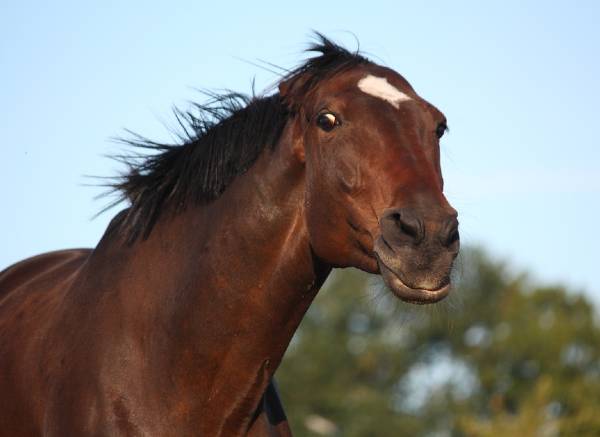
What About The Victim of a Horse Bullying Other Horses?
While there are different options available to help retrain the bully; there is usually one solution for the horse who is being bullied. In most cases, separation from the bully is the most effective way to help the horse who is the victim.
Where a horse is being severely victimized, immediate separation from the bully is the best option. This may involve removing either the victim or the bully from the herd. This will eliminate the risk of further serious physical injury.
It will also prevent the horse from becoming fearful of other horses. Some horses can become ‘horse shy’ – that is, they react in fear when another horse comes towards them. This can be retrained but can be difficult to do so depending on the level of fear.
It is recommended that the horses be kept separate until injuries have healed and a more permanent solution is found. This could mean that the victim is put in a different field, or that measures have been taken to retrain the bully.
Additionally, it is also recommended that the victim be checked over for any health issues. For example, an older horse with arthritis is at a much greater risk of being bullied. Their arthritis prevents them from moving out of the way fast enough when a more dominant horse comes along.
Some horses simply do better when kept in a field by themselves, alongside other horses or companions. At the end of the day, your horse’s well-being needs to come first. If they are happy and in good health, they will be less likely to become a victim – or a bully!
Is There a Way to Prevent a Horse From Bullying Other Horses?
As the common saying goes, prevention is better than a cure. There are many things you can do to prevent your horse from becoming a bully in the first place.
To start with, make sure your horse has plenty of social opportunities from a young age. Turning young horses out with an older, more experienced horse, can help them learn the right behavior. Giving your horse regular turnout time with other horses is a great way to maintain their social skills.
Consistent turnout will also help prevent the buildup of stress or frustration. Horses who are stabled often have more pent-up energy, which can turn into frustration if they aren’t given enough exercise.
This will also form part of a consistent routine, helping to reduce stress. You can read about different options when it comes to boarding your horse here.
Make sure your horse is kept with suitable herd mates. This means that compatibility factors like temperament, height, and personality are considered. Just as some people dislike each other, some horses feel the same way about each other.
Make sure your training techniques are effective at establishing yourself as the leader. This can help prevent the naturally dominant horse from turning into a full-time bully.
Lastly, regularly observing your horse’s behavior will go a long way in preventing bullying. If you already know which horse is the herd leader, you can watch for signs of bullying. As soon as they appear, you can take action, rather than waiting until it has been going on for a while.
Final Thoughts
Finding a way to stop a horse from bullying other horses requires patience and consideration. Identifying the underlying causes and considering the needs and training of each horse is just the start. Knowing how herd dynamics work is an important part of understanding how to create a safe and peaceful equine environment.

